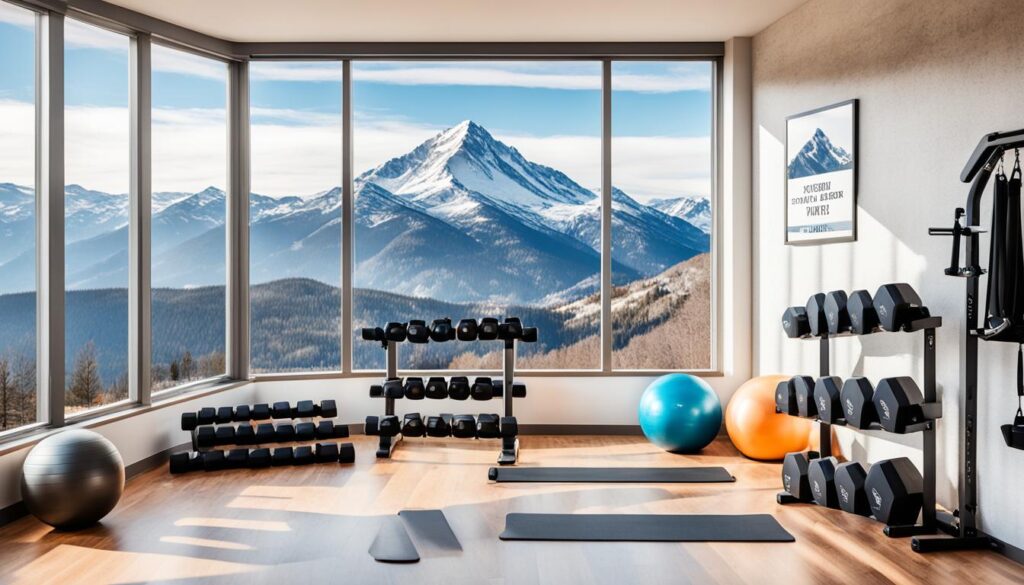Hiking and walking can take up a lot of time, making it hard to do long walks more than once a week. Starting intense walking routines for those who are not active can lead to injuries like plantar fasciitis, shin splints, or hikers knee. It’s crucial to prepare your body well before hitting the challenging mountain trails.
With the right training plan, you can get fit, lose weight, and build the fitness needed for big hiking adventures. A structured program that includes hiking, strength training, and conditioning is key. This method lowers your injury risk, makes hiking more fun, and lets you tackle tougher trails. By sticking to a balanced plan, you’ll get the endurance, strength, and resilience to conquer high peaks.
Key Takeaways
- Proper physical preparation is essential for hiking in the mountains.
- A structured training program combining hiking, strength training, and hiking-specific conditioning is the key to getting ready.
- This approach can help reduce your risk of injury, improve your enjoyment of the hike, and enable you to take on more challenging trails.
- Developing endurance, strength, and resilience through a balanced plan is crucial for conquering those towering peaks.
- Strength training is highlighted as the most underutilized tool for hiker training, providing essential benefits in injury prevention, elevation preparation, and reduced exertion during hiking.
Start With Basic Hiking Fitness Tips
Getting your body ready for hiking starts with simple exercises. These exercises help strengthen muscles and improve balance. Adding these basic fitness tips to your routine makes your body trail-ready.
Exercises to Build Strength and Stability
Try these exercises to work on key muscle groups for hiking:
- Resistance band exercises to build range of motion and stability
- Core-strengthening moves like crunches, planks, and mountain climbers
- Lower body exercises such as squats, lunges, and step-ups
- Upper body push-ups and pull-ups to build overall strength
Adding cardio like walking, running, or biking to your routine also boosts endurance for long hikes.
Starting with hiking fitness tips and exercises for hiking strength and stability is smart. It prepares your body for the trail. With a strong fitness base, you’re ready for your next hiking challenge.
Build a Home Gym for Hiker Training
Setting up a home gym with a few key items can help with home gym for hiking training. Dumbbells are great for building strength through weighted exercises. Resistance bands are perfect for strengthening your legs. And, shoes with flat soles are best for lifting and running, unlike trail shoes with deep treads. These essential gear for hiker training can help prepare your body for hiking.
Aerobic workouts are key for building endurance. They should be done weekly to get ready for hiking, backpacking, mountaineering, or ultra running. These workouts help you work out just below your lactate threshold heart rate. Beginners start with 5–20 minute intervals, while advanced athletes might do 40 minutes.
For strength training, a good workout has 4 sets of 8 reps with 30-60 seconds rest. Heavy lifting should include 3-5 exercises specific to your sport. Do these exercises 2-3 times a week, with 5 reps and 3 minutes rest between sets.
| Equipment | Benefits |
|---|---|
| Dumbbells | Build Strength |
| Resistance Bands | Leg Strengthening |
| Flat, Stable Shoes | Suitable for Lifting and Running |
These simple items can make your home gym a great place for preparing for hiking. By getting a few key pieces of equipment, hikers can create a versatile home gym for hiking training. This helps support their fitness goals.

Training Plan for Day Hikes
If you’re new to hiking or getting back into it, day hikes are a great place to start. Start by walking briskly 2-3 times a week for 30 minutes. This gets your heart rate up and prepares your body for hiking. Wear the same shoes you’ll use on the hike and carry a light daypack to get used to the feel of it.
This approach helps your body adjust to hiking demands before you tackle longer trails. It’s a smart way to build your fitness for day hikes.
To create an effective training plan for day hikes, consider the following:
- Gradually Increase Mileage: Begin with short, easy hikes and slowly increase the distance. This helps your body get used to the demands of hiking.
- Focus on Strength Training: Do exercises like squats, lunges, and step-ups to strengthen your legs. These muscles are key for hiking. Aim for 2-3 strength training sessions a week.
- Include Cardio Workouts: Add exercises like brisk walking, jogging, or cycling to boost your fitness and endurance.
- Practice Elevation Gain: If your hike will have a lot of ups and downs, train on hills or stairs. This prepares your body for the challenge.
- Listen to Your Body: Pay attention to how your body feels during training. Rest and recovery are key to avoiding injuries and keeping up your progress.
With a structured training plan for day hikes, you’ll be ready to hit the trails with confidence. You’ll also make the most of your outdoor adventures.
“Proper training is the key to a successful and enjoyable day hike. Gradual progression, strength building, and cardio are all essential components of an effective hiking training plan.”
– Stacey Hardin, Founder of Pique to Peak
The Best Strength Exercises for Hikers
Strength training is key for getting ready for hiking. It helps prevent injuries and boosts endurance. Focus on exercises that work the legs, core, and back.
Some top strength exercises for hiking are:
- Lunges – These strengthen the quadriceps, hamstrings, and glutes. They help with uphill climbs and staying stable on rough ground.
- The “Poor Man’s Leg Curl” – This targets the hamstrings. These muscles are crucial for hiking uphill and controlling your descent.
- Band Walks – These improve balance and joint stability by working the muscles around the hips and knees.
Creating a strength training plan for hiking should focus on full-body exercises. These exercises build overall strength. This helps you get the muscular endurance and stability needed for tough hikes.
| Exercise | Benefits for Hikers | Recommended Reps |
|---|---|---|
| Goblet Squats | Target quads, hamstrings, and glutes | 10-15 reps |
| Step-ups | Strengthen quads and glutes for climbing | 10-12 reps per leg |
| Downhill Lunges | Prepare quads for steep descents, strengthen stabilizer muscles | 8-10 reps per leg |
| Hanging Knee Raises | Build core strength for heavy backpack carrying | 10-12 reps |
| Kettlebell Deadlifts | Emphasize and strengthen hamstrings | 8-10 reps |
Always do dynamic stretching before your workouts and static stretching after. This keeps your muscles flexible and lowers injury risk. With a good best strength training for hikers routine, you’ll be ready for those essential strength exercises for hiking.

Prevent Injury on Tough Terrain
Hiking in the mountains can be hard on your knees. The constant impact from carrying your pack can cause injuries like “hiker’s knee.” It’s key to strengthen muscles like your quadriceps, calves, and hamstrings to avoid this.
Avoiding “Hiker’s Knee”
Doing exercises like weighted step-ups and resistance band work can help. Trekking poles also provide support on steep trails. Remember to warm up, cool down, and rest to prevent injuries.
For hikes over 4,500 feet of gain or loss, you need strong muscles and stable joints. Experienced hiker Ramsey Bergeron suggests adjusting your training by changing the distance, pack weight, and elevation. Start training without a pack to get used to uneven trails, then add more weight gradually.
Stairs or a Stairmaster can mimic mountain climbs if you can’t get to real mountains. Treadmill training with a steep incline helps too. But remember, mobility and flexibility exercises are key to preventing injuries.
- Try Bosu ball squats, planks, side planks, kneel-downs, and step ups and downs to strengthen your muscles and balance.
- Do strength training that works all three planes of motion to prevent injuries and strengthen important muscles for uneven terrain.
By focusing on injury prevention with the right training and gear, you can tackle even the toughest trails safely.
Choosing the Right Hiking Footwear
When it comes to best hiking boots and shoes, the right footwear is key for a safe and comfy hike. The right hiking footwear helps prevent blisters and ankle sprains. It makes hiking safer and more enjoyable.
It’s important to get fitted by an expert. They can suggest the best shoes based on the terrain, how much you’ll be carrying, and your needs. Think about ankle support, traction, and how easy they are to break in.
Hiking shoes are great for those looking for protection and value. Trail runners are perfect for comfort and speed. Water-resistant hybrids are ideal for cold or snowy hikes.
Buying quality hiking boots and shoes and breaking them in is crucial. Hiking shoes can last about 800 miles or 9-18 months. Trail runners should be replaced every 500 miles or 6-12 months.
Good hiking footwear can greatly improve your hiking experience. Take the time to find the right fit. Get your feet ready for the trail, and you’ll have a safe and fun hike.
| Footwear Type | Recommended Use | Durability |
|---|---|---|
| Hiking Shoes | Protection and good value | 800 miles or 9-18 months |
| Trail Runners | Comfort and performance | 500 miles or 6-12 months |
| Water-resistant Hybrids | Cold or snowy conditions | Longer than trail runners |
| Hiking Boots | Maximum protection and durability | Potentially thousands of miles |
The right hiking footwear is crucial for your outdoor adventure. Take the time to find the perfect pair. You’ll be ready for an unforgettable hike.
“Proper hiking footwear can make all the difference in preventing injuries and ensuring a comfortable, enjoyable experience on the trail.”
Training for Multi-Day Backpacking Trips
Getting ready for a backpacking trip means you need to train hard to get fit and strong. It’s key to prepare well before you start to avoid feeling sore or tired. You should start training three to five months before you leave.
Begin by adding more weight to your backpack on weekly hikes. This helps your body get used to carrying more. Try to go from 4-mile walks to 12-mile hikes in the mountains over time.
Strength training is also vital for long backpacking trips. Work on exercises that help your legs, core, and upper body. Do step-ups, planks, and pushups at least twice a week.
Boost your heart health with interval training. Do 20 seconds of work followed by 20 seconds of rest, repeat for 8 rounds. Also, stretch your hips, core, quads, hamstrings, and Achilles to avoid injuries and stay flexible.
Always talk to a doctor before starting any new exercise or diet plan. Use the same boots and socks you’ll wear on your trip to get used to them. This can make you more resilient.
Be flexible with your training and change it if you need to. Try to train with friends to get used to working together on the trail.
| Training Recommendation | Frequency |
|---|---|
| Strength Exercises (step-ups, planks, pushups) | At least 2 times per week |
| Interval Cardio (20 sec on, 20 sec off, 8 rounds) | At least 2 times per week |
| Flexibility Stretching (hip flexors, core, quads, hamstrings, Achilles) | 10 minutes, 2 times per day |
Training for three to five months will get you ready for your long backpacking trip. You’ll feel confident and strong for the adventure.
“The key to a successful multi-day backpacking trip is preparation. Gradually increasing your hiking distance and pack weight over several months will set you up for an enjoyable and safe journey.”
The Best Cardio for Mountain Hikes
When you can’t hike as much, hiking-specific cardio workouts keep you fit for the trail. Try loaded pack walks, hill repeats, stair climbing, sled pushes, and high-intensity interval training. These exercises mimic hiking uphill and carrying a pack, getting your body ready for mountain challenges.
For those who hike long distances, doing cardio and endurance training 2-3 times a week is enough. Make sure one day includes hiking with a pack, gradually getting ready for your big hike. An air bike machine is great for those with joint problems, letting you work out with any limbs you like.
The rower is another good choice. Start with a 5-10 minute warm-up and end with 5-10 minutes of easy work. Use intervals where you work hard for a bit, then rest for 3-4 times that amount. Start with 6-8 rounds and increase as you get fitter, aiming for a harder pace.
Try pyramids too, alternating between work and rest in a 1:1 ratio. Increase and decrease the workout time gradually. Keep the effort level steady throughout, aiming for an average intensity.
| Heart Rate Zone | Intensity Level | Example Activity | Duration |
|---|---|---|---|
| Zone 5 | 90% of max HR | Hiking up a 50% grade with a 40-lb. pack | 1-5 minutes |
| Zone 4 | 80-90% of max HR | Hiking up a 30% grade with a 40-lb. pack | 15-30 minutes |
| Zone 3 | 70-80% of max HR | Trekking up a 15% grade with a 40-lb. pack | 1 hour |
| Zone 2 | 60-70% of max HR | Walking up a 15% grade with a daypack | 1-2 hours |
| Zone 1 | 50-60% of max HR | Walking on the flats with a daypack | Until you get blisters |
Consistent training with a steady increase in difficulty is key. Include 2 strength sessions and rest well throughout the week. Using a heart rate monitor helps keep you in the right zone during workouts.
Getting ready for mountain hikes means doing exercises with extra weight and comparing your performance before and after. High effort, high altitude, or hard physical work can cause shortness of breath and CO buildup in the brain. But, going down 500 to 1,000 feet by hiking can help fix these altitude problems.
Conclusion
To get ready for tough mountain trails, mix hiking, strength training, and cardio workouts. Start with a basic fitness level and slowly increase your workout intensity and length. This approach will help you prepare for your outdoor adventures.
Whether you’re planning a day hike or a long backpacking trip, a good training plan is key. Focus on building strength, endurance, and flexibility. This will help you handle different landscapes, climb steep hills, and go down safely.
The first step to conquer a mountain is the right training plan. It ensures you’re ready both physically and mentally for the challenge. Enjoy the journey, listen to your body, and feel proud when you reach your hiking goals.
FAQ
What are some basic exercises to warm up and improve balance for hiking?
Start with running or walking in sand to warm up. Use resistance bands for better flexibility. Don’t forget to do crunches, squats, lunges, and push-ups. These exercises help prepare your muscles for hiking on rough terrain and carrying a pack.
What kind of home gym equipment is best for hiker training?
Free weights like dumbbells are great for building strength. Resistance bands are perfect for strengthening your legs. Choose shoes with flat, stable soles for lifting and running workouts. These are different from trail shoes with deep treads.
How should I prepare for a day hike?
Start preparing weeks before your hike by walking briskly 2-3 times a week for 30 minutes. Wear the same shoes you’ll use on the hike and carry a light daypack. This will help you get used to the conditions you’ll face.
What are the best strength training exercises for hikers?
Lunges are key for strengthening your legs. The “poor man’s leg curl” targets your hamstrings. Band walks also help by strengthening muscles around your hips and knees.
How can I prevent “hiker’s knee” on the descent?
Strengthen your quadriceps, calves, and hamstrings with exercises like weighted step-ups and resistance band work. Trekking poles can also help by providing extra stability and support on uneven ground.
What should I consider when choosing hiking footwear?
Think about ankle support, traction, and how long they need to break in. Good quality hiking shoes or boots are a must. Make sure to break them in before your hike to avoid blisters.
How should I train for a multi-day backpacking trip?
Slowly increase the weight of your pack during weekly hikes to get used to carrying more. Focus on strength training for your legs, core, and upper body. Aim for 4-6 weeks of training to build the fitness and endurance needed for backpacking.
What are some good cardio workouts to prepare for mountain hikes?
Try loaded pack walks, hill repeats, stair climbing, sled pushes, and high-intensity interval training on bikes or ellipticals. These exercises simulate the demands of hiking uphill and carrying a pack. They prepare your body for the cardiovascular challenges of mountain hikes.
















